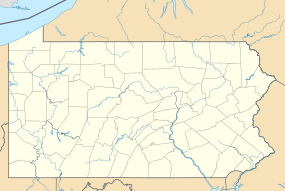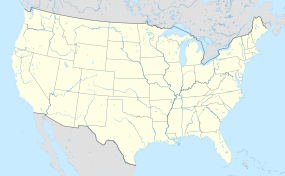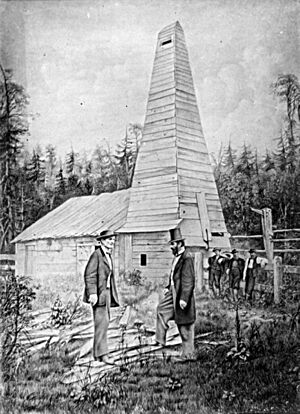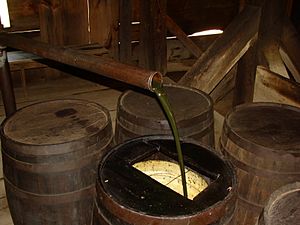Drake Well facts for kids
|
Drake Oil Well
|
|
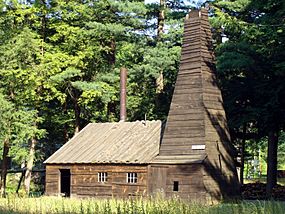
Replica engine house and derrick in June 2012
|
|
| Location | Cherrytree Township, Venango County, Pennsylvania |
|---|---|
| Nearest city | Titusville, Pennsylvania |
| Built | 1859 |
| Built by | Edwin Drake, William A. Smith |
| NRHP reference No. | 66000695 |
Quick facts for kids Significant dates |
|
| Added to NRHP | November 13, 1966 |
| Designated NHL | November 13, 1966 |
The Drake Well is a famous oil well in Pennsylvania, USA. It is about 69.5 feet (21.2 m)*. This well is super important because its success started the very first "oil boom" in the United States.
The well was drilled in 1859 by Edwin Drake. It's located near Oil Creek. Many people call it the first commercial oil well in the U.S. Today, the well is the main attraction at the Drake Well Museum. The museum is about 3 miles (5 km) south of Titusville.
The Drake Well is recognized as a special historical site. It became a National Historic Landmark in 1966. It was also named a Historic Mechanical Engineering Landmark in 1979. In 2009, it was made a National Historic Chemical Landmark. This happened on its 150th birthday!
Some other places also claim to have the first oil wells. These include wells in Azerbaijan, Ontario, and Poland. But the Drake Well is famous for a different reason. It sparked a huge wave of interest and money in oil. This led to more drilling, refining, and selling of oil. It truly kicked off the modern oil industry.
Contents
Where is the Drake Well?
The Drake Well is in Cherrytree Township, Venango County. This area is in northwestern Pennsylvania. The well sits about 150 feet (46 m) from the east bank of Oil Creek.
The spot where the well was drilled was once a small artificial island. This island was made by the creek and a channel called a mill race. The well and the museum are on a floodplain. They are kept safe from floods by a strong earthen dike.
How Oil Was Discovered
Native Americans knew about oil in Oil Creek for hundreds of years. It would naturally bubble up from the ground. Europeans learned about this "mineral-oil" in the 1600s. Back then, people mostly used it as medicine. They thought it could cure problems like rheumatism and arthritis.
Around 1848, a man named Samuel Kier saw another use for the oil. He realized it could be used to light lamps. Kier started to distill the oil. This process removed bad smells and impurities. It made the oil burn better without creating too much soot.
Later, a sample of oil from Oil Creek was taken to Dartmouth College. This happened around 1853. George Bissell got the sample. He and Jonathan G. Eveleth bought the farm where the oil was found. They paid $5,000 for it.
In 1855, Bissell and Eveleth sent another oil sample to Benjamin Silliman at Yale University. Silliman's report was very important. It confirmed that the oil was good quality. He also explained how to distill it to make kerosene. Kerosene was a much better fuel for lamps. After this, the Pennsylvania Rock Oil Company was started. The farm was then transferred to this new company.
Building the Well
Edwin Drake was a former train conductor. He put all his savings, $200, into the Pennsylvania Rock Oil Company. Drake became more involved and visited the farm in December 1857. His report convinced Bissell and Eveleth to create the Seneca Oil Company in 1858. They put Drake in charge of getting the oil.
Drake believed that drilling for oil, like drilling for salt, would work best. So, he hired William A. Smith. Smith was a blacksmith and had experience drilling salt wells. They built an engine house and a derrick. Drake bought a 6-horsepower (4.5 kW) steam engine. This engine was used to power the drill.
The drill pushed through the soil until it hit solid rock, about 32 feet (10 m) down. But groundwater kept making the hole collapse. So, Drake got 50 feet (20 m) of cast iron pipe. He used this pipe to keep the hole stable. Once they reached bedrock, Drake and Smith could drill about 3 feet (1 m) each day.
Drake's partners back in Connecticut started to lose hope by April 1859. They had spent $2,500. But Drake didn't give up. He took out a $500 loan to keep drilling. The drill reached its deepest point, 69.5 feet (21.2 m), on August 27, 1859. The next day, Smith visited the well. He saw oil floating on top of the water, about 5 inches (13 cm) from the top of the well!
The original buildings at the well burned down in October 1859. Drake rebuilt them a month later. The well produced about 12 to 20 barrels (2 to 3 m3) of oil each day. However, the price of oil dropped very quickly because so much oil was found. So, the well never made a profit. It stopped producing oil in 1861. The Seneca Oil Company sold the property in 1864. The derrick was later moved to an exhibition in Philadelphia in 1876.
Keeping History Alive
The well was left alone until 1889. Then, David Emery bought the site. He put up a new derrick and cleaned out the well. Emery found a small amount of oil. He wanted to sell it as souvenirs to raise money to protect the site. But he passed away before he could.
In 1913, Emery's widow gave the 1 acre (0.40 ha) of land, including the well, to a group called the Daughters of the American Revolution. This group placed a limestone rock with a bronze plaque at the well in 1914. This was to remember the important site.
In 1931, the American Petroleum Institute donated $60,000. This money was used to build a museum and a library. They also built a dike to protect the well from floods. The Institute said that when Pennsylvania took over the site in 1934, it should become a state park.
The Drake Well State Park was managed by the Department of Forestry and Waters. In 1943, it was moved to the Pennsylvania Historical Commission. For many years, visitors were disappointed that only the old drilling tools remained.
In 1945, the Pennsylvania government gave $185,000 to build a new derrick and engine house. This included working pumping equipment. The new buildings were made to look exactly like the originals. They used old photographs from the 1860s to make them perfect.
The Drake Well was officially added to the National Register of Historic Places and became a National Historic Landmark in 1966. In 1979, it was named a Historic Mechanical Engineering Landmark. In 1986, real working copies of the steam engine and boiler were bought and installed. On August 27, 2009, the 150th anniversary of the oil strike, the American Chemical Society named the Drake Well a National Historic Chemical Landmark.
Drake Well Museum
The Drake Well Museum covers about 22 acres (9 ha) of land around the well. The museum is recognized by the American Alliance of Museums. It also has a stop on the Oil Creek and Titusville Railroad.


